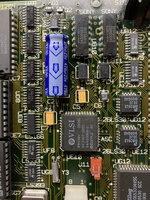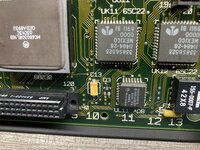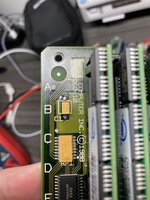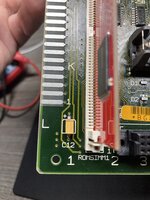Hello all. Longtime lurker, first time poster. It has been while since I owned a compact Mac, but recently came across an SE/30 for sale that was in surprisingly good shape. The seller insisted on booting it several times to show me it worked, and it seemed to boot fine to the internal SCSI, but had no audio. The external floppy connector also did not work.
I decided to have some fun with it so I ordered recap kits from Console5 for the logic board, analog board and Sony power supply. Before those arrived however I got my hands on a new 1/2AA battery, a Mac ROM-inator II, some new RAM from OWC, and a SCSI2SD unit. I installed the new ROM, RAM and SCSI2SD, and everything was still working quite well (minus audio). I was able to make fresh installs of system 6 and system 7 on the SCSI2SD with no problems (using my BMOW Floppy Emu that I'd acquired a while back for my Apple IIe projects).
So then the recap kits came in and I got to work on the logic board (have not touched the analog board or power supply yet). I removed the 13 caps, then cleaned the board several times with 99% isopropyl and a tooth brush. While it was obvious many of the caps had leaked, the corrosion could have been much worse. I saw no darkened traces, but I did see a few traces that looked partially exposed, so I covered those up with some UV resin before soldering anything. I replaced the caps with the ones from my Console5 tantalum kit, with the exception of C3, C4, C9 & C10, which I replaced with uprated 25V 47uF tantalum caps I got from Mouser. In the process I noticed that transistor Q3 had gone missing from corrosion, so I replaced that with a 2N3904 (did not have a surface mount MMBT3904 available). I then buzzed out all the traces to/from each capacitor to make sure my soldering was good, and I checked for accidental bridging with adjacent traces. All looked good.
I put the new ROM, new RAM, and battery back in it and fired it back up. Sadly, it now seems to be in a much worse state than before. You can see from the video that it displays typical simasimac video artifacts, and now has a fast ringing audio pattern which changes pitch after several seconds. I am a couple of days into troubleshooting, but have not made any progress at all. Below is what I have done so far, to no avail:
- Cleaned and re-seated ROM and RAM
- Swapped back to original ROM and original RAM, and also tried mixing old and new
- Double checked continuity on all capacitor traces, and double checked for bridging to nearby traces
- Downloaded all the schematics and successfully buzzed out traces between ROM, RAM, CPU and GLUE
- Tried pulling up UB11 audio chip with a 1K resistor across pins 7 and 15 (this turned the audio ringing into audio clicks, but did nothing else)
- On a whim, removed the 2N3904 at Q3 (simply to test, since the board had been working fine without it before)
TL;DR... None joy with any of the above. So in summary, the board was working well before my clean and recap, and now it's simasimac. I cannot see any darkened traces, and have successfully buzzed out most of the traces that people typically suggest would be related to these issues. I have found no discontinuity or bridging. The most corroded component seems to be UE8, but its traces seem fine.
I seem to be running out of common trouble shooting steps, with the exception of replacing the RP2 network filter. Is there any way to test it to see if it's bad? Though I don't know how likely it is that it spontaneously went bad as a result of my recapping...?
Any suggestions on where to go next with this board? Many thanks in advance. Video link below and hi-res photos attached.
VIDEO LINK:
I decided to have some fun with it so I ordered recap kits from Console5 for the logic board, analog board and Sony power supply. Before those arrived however I got my hands on a new 1/2AA battery, a Mac ROM-inator II, some new RAM from OWC, and a SCSI2SD unit. I installed the new ROM, RAM and SCSI2SD, and everything was still working quite well (minus audio). I was able to make fresh installs of system 6 and system 7 on the SCSI2SD with no problems (using my BMOW Floppy Emu that I'd acquired a while back for my Apple IIe projects).
So then the recap kits came in and I got to work on the logic board (have not touched the analog board or power supply yet). I removed the 13 caps, then cleaned the board several times with 99% isopropyl and a tooth brush. While it was obvious many of the caps had leaked, the corrosion could have been much worse. I saw no darkened traces, but I did see a few traces that looked partially exposed, so I covered those up with some UV resin before soldering anything. I replaced the caps with the ones from my Console5 tantalum kit, with the exception of C3, C4, C9 & C10, which I replaced with uprated 25V 47uF tantalum caps I got from Mouser. In the process I noticed that transistor Q3 had gone missing from corrosion, so I replaced that with a 2N3904 (did not have a surface mount MMBT3904 available). I then buzzed out all the traces to/from each capacitor to make sure my soldering was good, and I checked for accidental bridging with adjacent traces. All looked good.
I put the new ROM, new RAM, and battery back in it and fired it back up. Sadly, it now seems to be in a much worse state than before. You can see from the video that it displays typical simasimac video artifacts, and now has a fast ringing audio pattern which changes pitch after several seconds. I am a couple of days into troubleshooting, but have not made any progress at all. Below is what I have done so far, to no avail:
- Cleaned and re-seated ROM and RAM
- Swapped back to original ROM and original RAM, and also tried mixing old and new
- Double checked continuity on all capacitor traces, and double checked for bridging to nearby traces
- Downloaded all the schematics and successfully buzzed out traces between ROM, RAM, CPU and GLUE
- Tried pulling up UB11 audio chip with a 1K resistor across pins 7 and 15 (this turned the audio ringing into audio clicks, but did nothing else)
- On a whim, removed the 2N3904 at Q3 (simply to test, since the board had been working fine without it before)
TL;DR... None joy with any of the above. So in summary, the board was working well before my clean and recap, and now it's simasimac. I cannot see any darkened traces, and have successfully buzzed out most of the traces that people typically suggest would be related to these issues. I have found no discontinuity or bridging. The most corroded component seems to be UE8, but its traces seem fine.
I seem to be running out of common trouble shooting steps, with the exception of replacing the RP2 network filter. Is there any way to test it to see if it's bad? Though I don't know how likely it is that it spontaneously went bad as a result of my recapping...?
Any suggestions on where to go next with this board? Many thanks in advance. Video link below and hi-res photos attached.
VIDEO LINK:
Attachments
Last edited:






